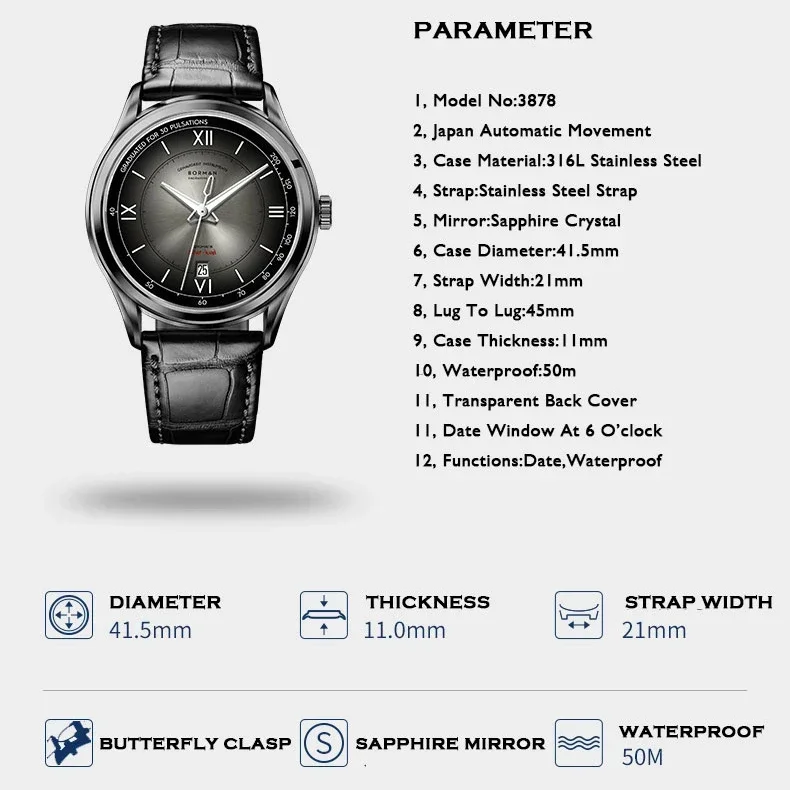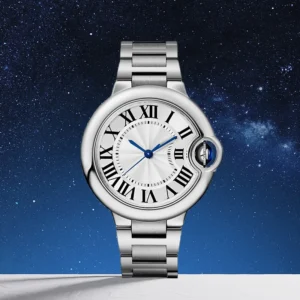Introduction: The Timepiece Spectrum
Watches have long transcended their primary function of telling time. Today, they serve as powerful statements of personal style, status, and purpose. Like fine clothing, watches exist on a spectrum—from the highly formal to the casually rugged—with each timepiece designed to complement specific occasions and lifestyles.
At one end of this spectrum sits the dress watch: the epitome of horological elegance. These refined timepieces are characterized by their slim profiles, clean dials, and understated sophistication. A proper dress watch doesn’t demand attention; rather, it subtly enhances formal attire while adhering to traditional design principles. The distinct features of dress watches have evolved from pocket watches of bygone eras, maintaining their connection to formal traditions.
At the other end are what we commonly call “normal watches”—a broad category encompassing everything from casual everyday timepieces to specialized sports models. These watches prioritize versatility, durability, and functionality, often featuring larger cases, more complications, and robust construction.
Understanding the differences between these two watch categories helps enthusiasts make informed choices for different occasions and personal needs. Throughout this article, we’ll explore the key distinctions in design philosophy, physical characteristics, appropriate occasions, and style considerations that separate dress watches from their everyday counterparts.
What Defines a Dress Watch: Elegance in Simplicity
A dress watch is not merely a watch worn with formal attire—it’s a distinct category of timepiece designed specifically for elegant occasions. The philosophy behind classic dress watches centers on understated refinement that complements, rather than competes with, formal clothing.
The core principles governing dress watch design have remained largely consistent for decades:
- Simplicity: Clean, uncluttered dials with minimal ornamentation
- Thin Profile: Slender cases designed to slip easily beneath shirt cuffs
- Restraint: Absence of flashy elements or excessive complications
- Proportion: Modest case sizes, typically between 36-40mm
- Elegance: Polished finishes and refined details
Historically, dress watches evolved from pocket watches, adopting their clean aesthetic while modifying the form for wrist wear. Unlike their more robust counterparts, dress watches prioritize refined aesthetics and masterful automatic dress watches craftsmanship over complex functionality or durability features.
What makes a true dress watch special is its ability to “disappear” at the right moments. It should enhance your formal attire without drawing undue attention, revealing its quality only upon closer inspection. This restraint is precisely what makes dress watches so sophisticated—they whisper rather than shout.
Understanding “Normal” Watches: Versatility for Everyday Life
While dress watches occupy a specific, formal niche, “normal” watches encompass a far broader category of timepieces designed for daily wear across various contexts. These everyday watches strike a balance between function, durability, and style—offering versatility that dress watches intentionally sacrifice for elegance.
Understanding watch features is essential for appreciating how normal watches differ from their dressier counterparts. Unlike dress watches, everyday timepieces typically prioritize readability, durability, and practical functions over maintaining a slim profile or adherence to formal design rules.
Normal watches include several distinct subcategories, each with its own heritage and purpose:
- Casual watches: General-purpose timepieces designed for everyday wear with contemporary styling
- Field watches: Rugged timepieces with military heritage, emphasizing legibility and durability
- Dive watches: Purpose-built for underwater exploration with rotating bezels and substantial water resistance, like those found in our automatic dive watches collection
- Pilot watches: Originally created for aviation with high legibility and navigation features
- Chronographs: Watches with stopwatch functionality for timing events
- Sports watches: Robust designs intended to withstand active lifestyles
These everyday watches typically feature larger cases (40-44mm), more prominent markers, enhanced water resistance, and practical complications like date displays, chronograph functions, or additional time zones. They often utilize metal bracelets, rubber straps, or canvas bands rather than the leather typically associated with dress watches.
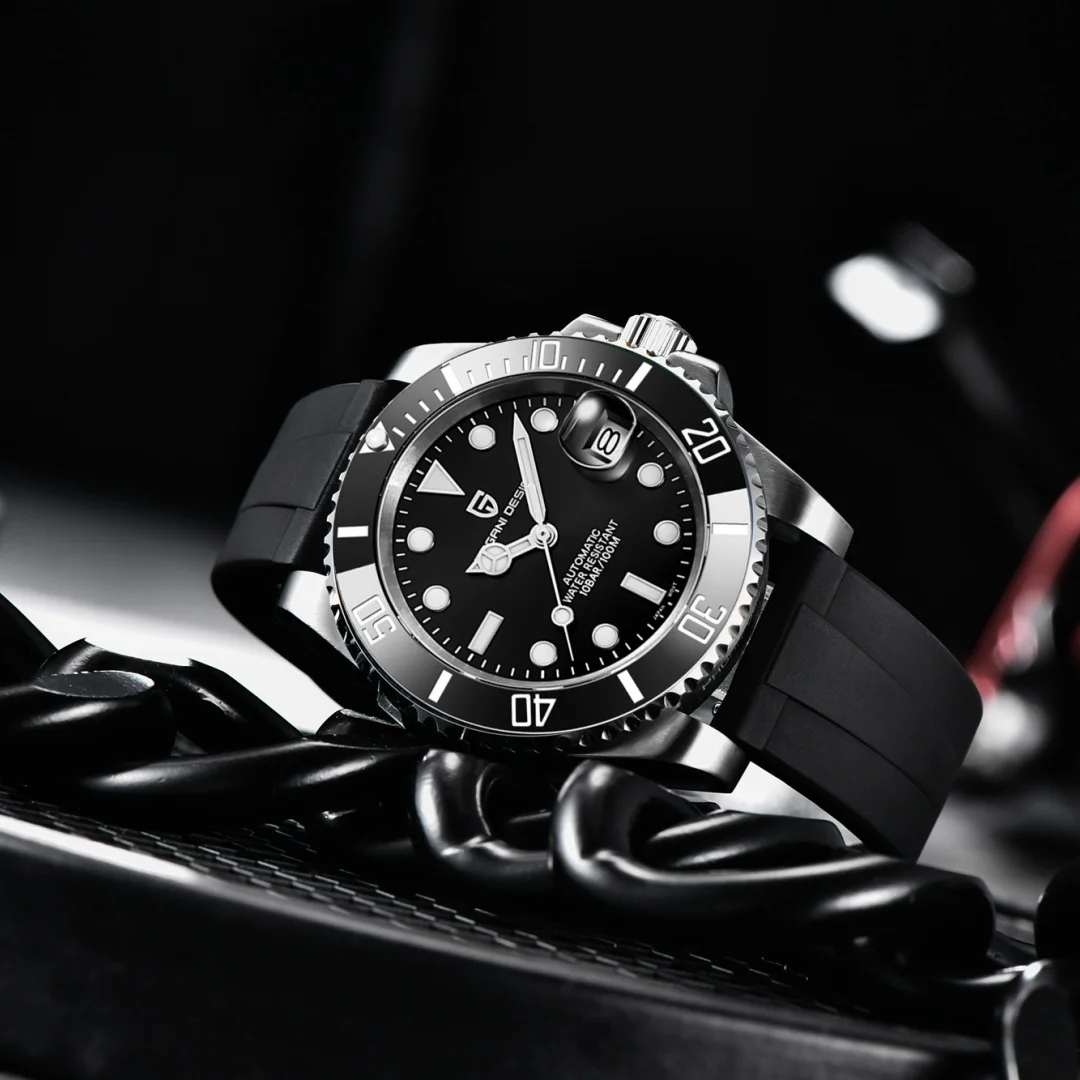
Side-by-Side: Key Physical Differences
The physical characteristics of dress watches and normal watches differ significantly, with each design choice serving their distinct purposes. The following comparison highlights these key differences:
| Feature | Dress Watch | Normal Watch |
|---|---|---|
| Case Size | 36-40mm diameter | 40-45mm diameter |
| Thickness | 7-10mm (ultra-thin) | 11-15mm+ |
| Dial Design | Clean, minimal | Often busier with subdials/complications |
| Hands & Markers | Slim, refined | Bold, highly visible |
| Case Material | Precious metals, polished steel | Primarily stainless steel, titanium |
| Crystal | Sapphire or mineral glass | Sapphire with anti-reflective coating |
| Strap/Bracelet | Typically leather | Steel, rubber, NATO, leather |
| Water Resistance | Minimal (30-50m) | Substantial (100-300m+) |
| Lume | Minimal or none | Generous for nighttime visibility |
| Crown Size | Small, unobtrusive | Larger, sometimes with guards |
| Weight | Lightweight | Heavier, substantial |
These physical differences aren’t arbitrary but directly reflect each watch type’s intended purpose. Dress watches maintain a slim profile to slide easily under shirt cuffs during formal occasions—hence their thinner cases and smaller crowns. The dress and casual watches guide illustrates how these differences serve specific wearing contexts.
Normal watches, conversely, are built for varied environments and activities, necessitating more substantial construction. Their larger dimensions improve legibility during sports or outdoor activities, while increased water resistance protects against daily hazards.
The use of different materials further highlights this distinction. Dress watches often feature precious metals that enhance their formal appeal but might be impractical for daily wear. Everyday watches prioritize durability with materials like hardened stainless steel or scratch-resistant titanium. For those who appreciate elegance with modern proportions, thin automatic dress watches offer an ideal balance of refinement and wearability.
Function and Features: Simplicity versus Capability
When comparing dress and normal watches, one of the most striking differences lies in their approach to functionality and complications (additional features beyond basic time-telling).
Dress watches embrace minimalism, typically offering:
– Hours and minutes (sometimes without seconds)
– Occasionally a small date window
– Rarely, a moonphase display or power reserve indicator
– Manual or automatic winding mechanisms
– No luminescent materials
This deliberate restraint in the quintessential guide to dress watch features reflects the formal contexts in which these watches are worn—environments where checking the precise time is a subtle gesture rather than a practical necessity.
In contrast, normal watches often feature multiple complications, including:
– Chronograph (stopwatch) functions
– Date and day displays
– GMT functions for tracking multiple time zones
– Rotating bezels for timing events
– Tachymeter scales for speed calculations
– Substantial luminous material for low-light visibility
– Greater water resistance for practical everyday use
These functional differences stem from their differing purposes. Dress watches are designed for occasions where elegance takes precedence over utility. Normal watches, however, are tools meant to serve their wearers throughout various daily activities—from office work to weekend adventures.
Movement choice also varies between these categories. While both may use automatic or manual mechanisms, dress watches typically feature thinner movements to maintain their slim profile. Normal watches have more freedom to use robust movements with additional functions, even if it results in a thicker case.
Appropriate Occasions: When to Wear Each Type
Knowing when to wear each type of watch is essential for matching your timepiece appropriately to different occasions and dress codes.
Ideal Settings for Dress Watches:
– Black tie events and formal galas
– Business formal settings and important meetings
– Weddings and ceremonial events
– Fine dining establishments
– Theater performances and upscale cultural events
Ideal Settings for Normal Watches:
– Daily office work in business casual environments
– Casual social gatherings and weekend activities
– Sports and outdoor adventures
– Travel and everyday errands
– Most modern business environments
The concept of “dressing up” versus “dressing down” applies particularly well to watches. A dress watch should complement formal attire without drawing attention away from the overall presentation. The definitive guide to dress watch design explains how these timepieces should work harmoniously with formal clothing, particularly suits and tuxedos.
Normal watches, especially luxury sports models, can sometimes be “dressed up” for business casual settings, while dress watches are difficult to “dress down” without creating a visual disconnect. The best approach is to match the watch’s formality level with your attire—pairing the refined elegance of a dress watch with formal clothing and saving sportier models for more casual ensembles.
For those who attend varied social events, having both watch types offers the flexibility to always have an appropriate timepiece for any occasion.
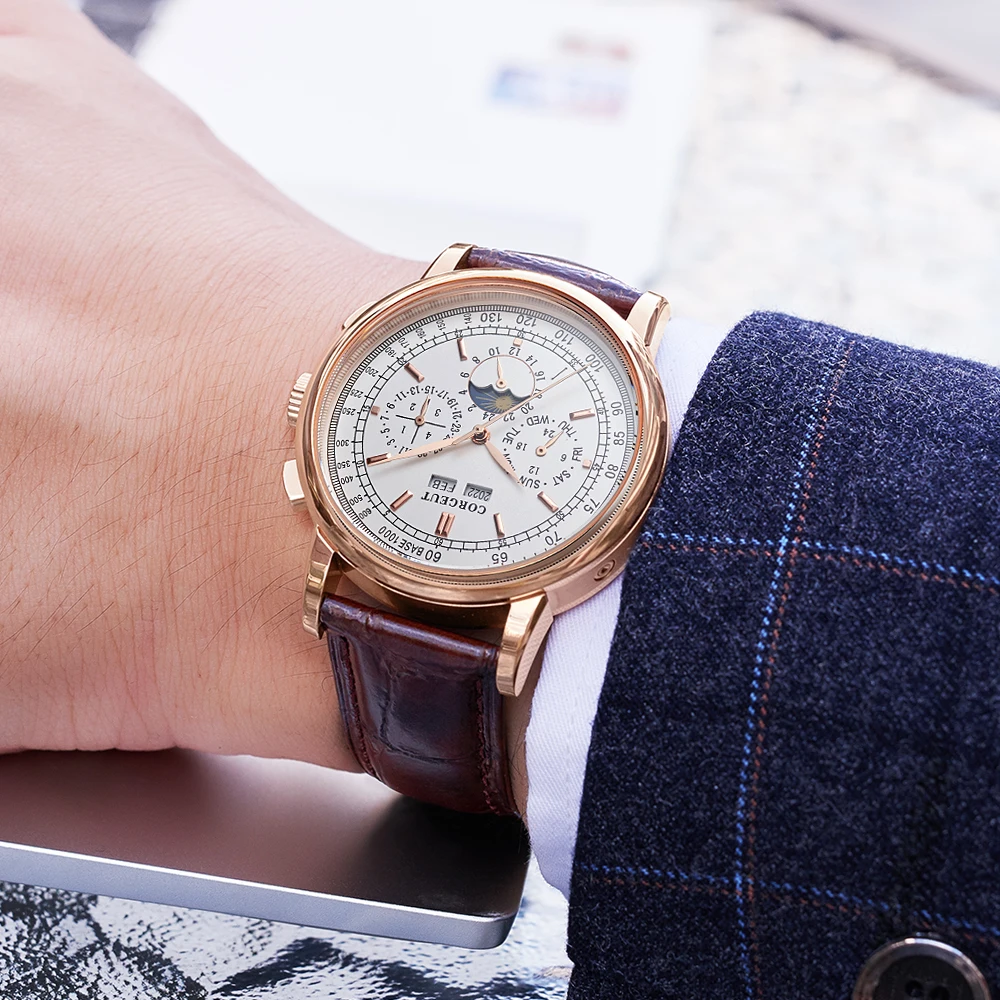
Style Considerations: Making a Statement
Beyond their physical differences and appropriate occasions, dress watches and normal watches make fundamentally different style statements.
A dress watch communicates refinement, appreciation for tradition, and understated luxury. Its power lies in its restraint—the carefully considered proportions, the quality of its finishing, and the subtlety of its design elements. The definitive guide to dress watch dials reveals how even minor details like hand shape and dial texture contribute to this elegant aesthetic. These watches speak to those who understand that true luxury often whispers rather than shouts.
Normal watches, by contrast, project personality, practical capability, and specific interests. A dive watch suggests adventure and capability, while a chronograph might indicate precision and technical appreciation. These watches often become conversation starters and can serve as the focal point of an outfit rather than a complementary accessory.
Material choices further emphasize these different statements. Dress watches typically feature polished surfaces, precious metals, and leather straps that convey formality. Normal watches embrace a wider range of finishes, materials, and colors that can express individual style more boldly.
Whether a watch becomes a subtle complement or a bold statement piece depends largely on which category it falls into—and understanding this distinction helps wearers make choices that align with their intended impression.
Blurring the Lines: Modern Interpretations
While traditional definitions of dress and normal watches remain useful, contemporary watchmaking increasingly blurs these once-clear boundaries. Modern watch design often combines elements from both categories, creating versatile timepieces that can transition between different settings.
Several trends illustrate this evolution:
– Dress watches with slightly sportier elements like luminous hands
– Sports watches with refined finishes suitable for business settings
– “Smart casual” watches that balance formality and functionality
– Luxury sports models that use precious metals in robust designs
The growing popularity of “dress divers”—watches that combine the water resistance and durability of a dive watch with the refined aesthetics of a dress piece—perfectly exemplifies this trend. Similarly, open heart and skeleton watches bridge formal and casual categories by displaying mechanical artistry in designs that can suit various settings.
This blending reflects broader shifts in fashion and professional norms, where rigid dress codes have relaxed and versatility is increasingly valued. However, for true formal events where traditional etiquette still applies, a proper dress watch remains irreplaceable.
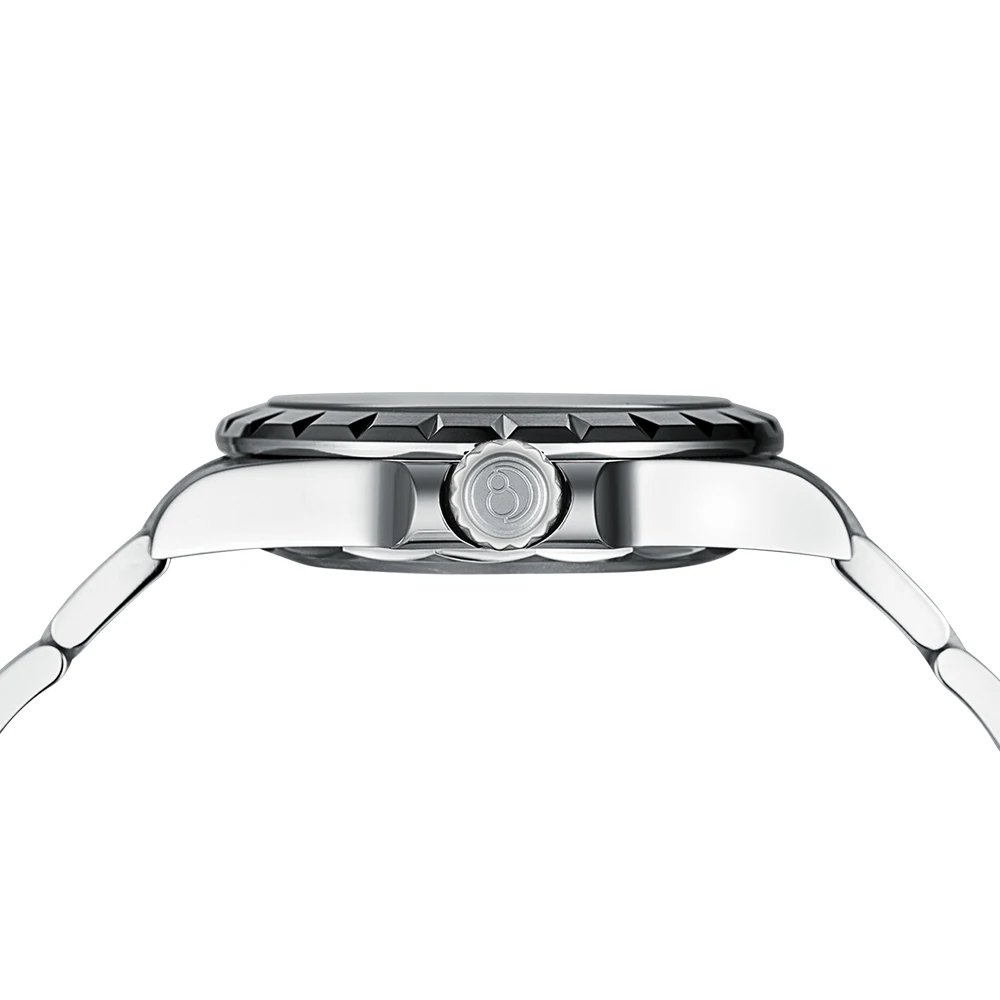
Choosing the Right Watch for Your Needs
Selecting between a dress watch and a normal watch depends on several personal factors. Consider these aspects when making your decision:
Lifestyle Assessment:
– How formal is your typical work environment?
– Do you regularly attend events requiring formal attire?
– How active are you during a typical day?
– What types of activities do your watches need to withstand?
Wardrobe Evaluation:
– Does your wardrobe lean formal (suits, dress shirts) or casual (jeans, t-shirts)?
– Would the watch need to pair with multiple outfit styles?
– What metals (gold, silver, steel) do you typically wear in other accessories?
Practicality Considerations:
– Do you need to frequently check the time in low-light conditions?
– Will the watch be exposed to water, impacts, or other hazards?
– How important are additional functions like date displays or chronographs?
Collection Context:
– Is this your only watch or part of a growing collection?
– Are you filling a specific gap in your existing collection?
– What watches do you already own that might overlap in purpose?
For those who can afford only one quality timepiece, a versatile watch that leans slightly dressier or sportier (depending on your lifestyle) might be ideal. Learning how to identify a dress watch helps ensure you’re making an informed choice aligned with traditional horological categories.
Can You Wear a Dress Watch Every Day?
This common question deserves careful consideration. While traditionally designed for formal occasions, many people do choose to wear dress watches daily. Here’s what to consider:
Advantages of Daily Dress Watch Wear:
– Elegant appearance that elevates casual outfits
– Versatility with business and smart-casual attire
– Typically lighter and less obtrusive on the wrist
– Classic design that doesn’t look dated or trendy
– Fits more easily under shirt cuffs and sleeves
Disadvantages to Consider:
– Limited water resistance for daily activities
– More susceptible to scratches (especially crystal and case)
– Leather straps require more frequent replacement when worn daily
– May lack practical features like luminous markers for low light
– Could appear overly formal with very casual clothing
If you prefer the refined aesthetic of classic and modern dress watches for daily wear, look for models with enhanced durability features like:
– Improved water resistance (at least 50-100m)
– Sapphire crystal for scratch protection
– Stainless steel case rather than precious metals
– High-quality leather strap or the option to swap for a more casual band
Many contemporary dress watches incorporate these practical elements while maintaining their elegant appearance, making them suitable for everyday use while still appropriate for dressier occasions.
Is a Sports Watch Appropriate for Formal Occasions?
While purists maintain that only proper dress watches belong with formal attire, modern fashion has become increasingly flexible. Here’s guidance on navigating this question:
For black-tie events and traditional formal occasions, a true dress watch remains the appropriate choice. However, for many modern business and “creative formal” settings, certain sports watches—particularly classic style dive watches—have gained acceptance.
Features that make a sports watch more formal-friendly include:
– Clean dial design with minimal complications
– Smaller or mid-sized case (under 42mm)
– Polished surfaces rather than brushed finishes
– Metal bracelet (or leather strap for non-dive models)
– Neutral colors (black, white, silver, blue)
– Thinner profile compared to typical sports models
– Higher-end materials and finishing
The concept of “luxury sports watches” specifically addresses this crossover territory. These pieces maintain the durability and functionality of sports watches while incorporating refined design elements and premium materials that allow them to work in more formal contexts.
Remember that context matters—what’s appropriate in a creative industry might not be suitable for traditional banking or legal environments.
Classic Automatic Dress Watches, Day Date Automatic Watches, Perpetual Calendar Automatic Watches
Price range: $540.60 through $574.60 Select options This product has multiple variants. The options may be chosen on the product pageClassic Automatic Dress Watches, GMT Automatic Watches, GMT Pilot Watches
Price range: $1,240.86 through $1,463.33 Select options This product has multiple variants. The options may be chosen on the product pageAutomatic Chronograph Watches, Classic Style Dive Watches
$3,053.06 Select options This product has multiple variants. The options may be chosen on the product pageBronze Automatic Watches, Military Inspired Automatic Watches, Professional Spec Dive Watches
Price range: $1,442.21 through $1,442.82 Select options This product has multiple variants. The options may be chosen on the product pageClassic Automatic Dress Watches, Thin Automatic Dress Watches
$437.64 Select options This product has multiple variants. The options may be chosen on the product pageProfessional Spec Dive Watches, Titanium Automatic Watches
$574.74 Select options This product has multiple variants. The options may be chosen on the product page
Collecting Both: Building a Versatile Watch Wardrobe
For watch enthusiasts, owning both dress and normal watches creates a versatile collection that can address any occasion. Here’s guidance on building a thoughtful, complementary collection:
A well-rounded two-watch collection might include:
– A versatile dress watch with clean design and moderate water resistance
– A robust sports watch (dive, field, or chronograph) for casual and active situations
For those building a three-watch collection, consider:
– A dedicated formal dress watch for special occasions
– A versatile everyday watch with some refinement
– A purpose-built sports watch aligned with your activities
When expanding beyond these basics, focus on pieces that offer distinct functionality or aesthetic appeal rather than duplicating similar styles. The classic automatic dress watches category offers excellent starting points for the formal side of your collection.
The key to a satisfying collection is ensuring each piece serves a specific purpose while maintaining a cohesive overall aesthetic that reflects your personal style.
Maintenance Considerations: Caring for Different Watch Types
Dress and normal watches have different maintenance needs due to their construction and typical usage patterns:
Dress Watch Care:
– Store in a watch box or pouch when not worn
– Keep leather straps away from water and excessive sweat
– Clean with a soft, dry cloth and avoid harsh chemicals
– Handle with care to prevent scratches on polished surfaces
– Service roughly every 3-5 years depending on movement
– Protect from sudden temperature changes and magnetic fields
Normal Watch Care:
– Rinse with fresh water after exposure to salt water or chemicals
– Regularly clean bracelets and rubber straps to remove dirt buildup
– Check water resistance seals annually if used for swimming
– Rotate the bezel (if applicable) regularly to prevent seizing
– Service roughly every 3-5 years or as recommended
– Monitor for condensation after water exposure
The different materials found in each watch type dictate these varying care needs. Dress watches often feature more delicate components and finishes that require gentler handling, while normal watches are built to withstand more rigorous conditions but need regular maintenance to preserve their protective capabilities.
Investment Value: Which Type Holds Value Better?
When considering watches as potential investments, both categories offer different value propositions:
Dress watches, particularly those from established brands with historical significance, often maintain value through their timeless design, precious materials, and connection to traditional watchmaking. Their classic styling typically avoids trends, making them less susceptible to shifting fashion preferences.
Normal watches, especially purpose-built sports models with iconic designs, can also retain or increase in value—particularly limited editions or models with technical innovations. Their durability means they often survive in better condition over time, potentially preserving more value.
Factors that contribute to value retention across both categories include:
– Quality of craftsmanship and movement
– Brand heritage and reputation
– Condition and completeness (box, papers, accessories)
– Rarity and production numbers
– Historical or technical significance
While investment potential can be a consideration, most horological experts suggest purchasing watches primarily for enjoyment rather than expected returns. The emotional value and daily pleasure derived from wearing a fine timepiece often exceeds any financial appreciation.
Finding Your Perfect Timepiece
Whether you choose the refined elegance of a dress watch or the robust versatility of a normal watch ultimately depends on your lifestyle, preferences, and needs. Each category offers its own distinctive strengths—the dress watch with its timeless sophistication and the normal watch with its practical functionality.
Remember that these categories serve as useful guidelines rather than strict rules. Modern watch design increasingly blurs traditional boundaries, creating pieces that can transition between different settings with ease.
When selecting your next timepiece, consider how it fits into your existing wardrobe, daily activities, and the occasions you typically attend. Focus on quality craftsmanship that will stand the test of time, regardless of the category you choose.
The perfect watch is ultimately one that brings you joy each time you glance at your wrist—whether that’s an elegant dress watch that whispers sophistication or a capable everyday timepiece ready for whatever your day brings.

